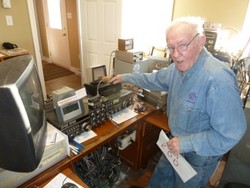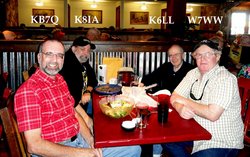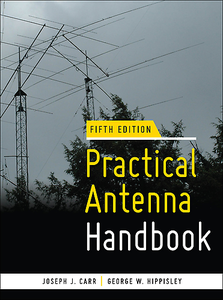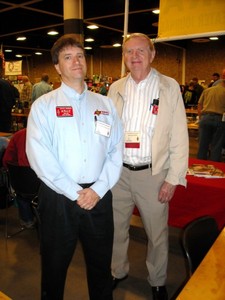 February 1, 2012 Editor: Ward Silver, NØAX | |||||||
IN THIS ISSUE
NEW HF OPERATORS - THINGS TO DO February is jam-packed with contests. If you feel up to the pressure, try one of the North American Sprints. Digital operators will be punching the keyboard in CQ WPX or XE RTTY contests. If you have some "big iron" (old tube radios) holding down the table, try the Classic Exchange's phone weekend. BULLETINS There are no bulletins in this issue BUSTED QSOS Occasional problems with URLs have been traced to the web editor tool adding "%20" to URLs at the end of a line of text. Should a URL seem to be non-functional, trying removing those characters and try again. (Thanks, Bob N6TV) CONTEST SUMMARY Complete information for all contests follows the Conversation section February 4-5
February 11-12
Making a lot of award-chasing contesters happy, the ARRL's Logbook of the World program (LOTW) will soon support CQ-sponsored operating awards. Announced on January 24th by ARRL COO Harold Kramer WJ1B and CQ Communications President Dick Ross K2MGA, the first award to be supported will be CQ WPX with a target date of April 1st, 2012. (No joke!) Standard LOTW and CQ award fees will still apply. As ARRL CEO Dave Sumner K1ZZ observes, "LoTW has significantly increased interest and participation in the ARRL's DXCC, Worked All States and VUCC awards programs. We anticipate a similarly positive response to the addition of the CQ WPX award. Amateurs will be able to spend more time operating and less time chasing QSL cards." Amen to that!
Having made a big splash across the pond with high-performance VHF+ antennas, the British company InnovAntennas has appointed its first American dealer - Hamilton, Ohio's R&L Electronics. Featured in European journals such as DUBUS, American "early adopter" hams began trying designer Justin Johnson GØKSC's LFA (Loop Fed Array) and OP-DES (Opposing Phase - Driven Element System) Yagis. InnovAntennas' American partner is well-known contester Bill Hein AA7XT. Dinner reservations and Tickets are now available for the 23rd Annual Dayton TopBand Dinner to be held on Friday evening, May 18, 2012 at the Crowne Plaza hotel in downtown Dayton, Ohio. Frank Donovan, W3LPL will be the main speaker. (Thanks, Tim K3LR) More HF activity from Thailand is expected soon, at least partially due to the effective emergency search and rescue communications provided by Thai hams during the recent severe floods in that country. According to Fred K3ZO, "Effective immediately Thai authorities have announced that any Thai ham holding a US General Class or Extra Class license can apply to have their Thai license upgraded to Thai Intermediate Class which means they will have HF privileges. Thai authorities have also granted permission for the Radio Amateur Society of Thailand to conduct a Thai Intermediate Class examination on May 19. This will be the first time in nine years that this examination has been offered. The Intermediate Class license affords HF privileges with 200 watts power." This is good news to DXers and contesters - a tip of the cap to the Thai hams for an emergency communications job well done! The Contest Update has on occasion mentioned articles in High-Frequency Electronics, edited by contest aficionado Gary K9AY. Well, Gary has a new magazine, RF Technology International. The inaugural Jan 2012 issue features include an article on HF aviation receivers and a tutorial on the Magic Tee hybrid combiner/divider which, by sheer coincidence, Gary uses for his receiving antenna system at home. Good stuff!
Stitching Morse code into the fabric of our lives has moved beyond the metaphorical and described in this how-to article on knitting. (Thanks, Mark N5OT) If you want to know where that tower base hole would emerge if you kept right on digging, now you can find out at Tunnel to the Other Side of the Earth. I think I'll need a wet suit. (Thanks, Steve WB8IMY) Doug KR2Q found out that the version of the Firefox add-on Propfire at the URL given in the last issue only worked with Firefox version 3. Fortunately, he also discovered an updated version that works with the current revisions of Firefox. This week's handy map gadget was contributed by Bob N6TV who located this interactive topo map that offers features useful to hams scouting out QTHs and antenna locations. Not only does the map tell you the elevation, it tells you the slope angle and slope direction of US locations, as well. Sad news came last week of the death of Aruba contest operator and host, Joop P43JB. Frequent Aruba operator Andy AE6Y recalls, "Joop and Yvonne have been extremely hospitable to visiting hams on Aruba. I and others using the P4ØL-P49Y station would get together with them on every trip, and have fond memories of drinking Heinekens and Balashis (Aruban beer) on his outdoor patio. There are some pix of Joop (and his key collection and very complex shack) on our website. He will be greatly missed." (Thanks also to Carl AI6V/P4ØV) Web Site of the Week - Paul W5DM touched a lot of ham radio heartstrings recently with his post on the TopBand reflector recounting his 75 years of ham radio experience. It makes for great reading - what will we be writing in our memoirs 75 years from now? WORD TO THE WISE Attenuation - often neglected, the attenuator button can be your receiver's best friend when a band full of gigantic signals is proving too much to handle. Attention to receiver gain pays big dividends in listening comfort and reducing operator fatigue. This recent video of Erin AK4JG's balloon launch and APRS tracking has garnered quite a bit of attention as a good example of the Do-It-Yourself aspects of Amateur Radio. Ballooning is really taking off as a popular ham radio hybrid for students and science-oriented groups. (Thanks, Allen W1AGP)
The position of the Sun in the sky moves around with the seasons and this Astronomy Picture of the Day shows the result of a year's worth of photography - in a single shot! Would you wait for a traffic light at -51 C°? Watch this video to see these residents of Yakutsk, Siberia take the frigid temperatures in stride. (Thanks, Doug K1DG) Initial results for the 2011 ARRL CW Sweepstakes are now live on the ARRL Contest Branch website. SSB preliminary results are not far behind. Remember, this article is the "just-the-facts-ma'am" numbers. The searchable database, log checking reports and the Expanded Results article will be online in April. Certificates for the 2011 ARRL DX CW hit the mail today and the Phone contest's certificates and plaques will follow shortly. (Thanks, Sean KX9X) 2009 ARI International DX Contest results are now available on the ARI web site in the HF > Contest > Risultati section. (Thanks, ARI HF Contest Manager, Bob I2WIJ) Final results of the Portugal Day Contest 2011 were uploaded to the web. The sponsors remind everyone that the rules for the contest have changed to a 24-hour period. (Thanks, Filipe CT1ILT / CR6K) OPERATING TIP Don't forget to turn OFF or clear the RIT after a QSO - or you'll be off frequency for the next one and wondering why you don't get through so quickly! Some logging programs allow you to command the radio to do that at the end of the QSO but it's a good habit to develop on your own. (Thanks, Tom W8TK) The late G4FGQ created a number of useful calculator utility programs such as this radial calculator that includes the conductivity of the soil. With it you can begin to answer the question, "How many ground mounted radials do I need and how long do they need to be?" All such calculators are a model and probably deviate from an exact simulation but you can get an idea of what might work. Another tack is to vary the radial length but keep the number of radials constant. (Thanks, Bob N6TV)
Fork-lift pallets are cheap, sturdy, and widely available - how about making some furniture out of them? Like maybe an operating desk as shown in this Instructables article! Chris N7ZWY has released a paper on his KISS Mixer that includes a PCB layout for the mixer and an LO driver circuit. The paper goes into quite a bit of detail including comparisons to other mixer designs. In the quest for connector tightening tools, Greg W8WWV came up with this screwdriver-style tool for type F and BNC connectors via the Home Depot stores. If the URL proves too long for your browser, search for Ideal 35-046. Speaking of tools...when we go to multiops or Field Days or work parties, it's easy to lose track of your tools. To avoid tool trauma, here's a Boing Boing article with some ideas for marking your tools for easy identification. (Thanks, Zhu Zhu Xiao) Randy AB9GO reminds us to be extremely cautious when using a voltmeter to measure high voltages. Be SURE the meter is adequately. Older meters in particular are often unsafe - such as the popular Simpson 260 that had a 5 kV range. Modern meters such as the Fluke 87 series are rated for 600V category IV and 1000V category III environments, can withstand high voltage transients and are constructed to protect the user against arc flash. Even with all the protection, remember that power supply capacitors store a lot of energy that can do significant damage.
Here's a tip for solder tips from Instructables that reminds us inexpensive brass kitchen scrubbing pads can be used instead of expensive specialized solder tip cleaners; stick one in a container and dab away! Ian G3NRW has just spruced up his AIM4170 antenna analyzer resources web page including a recent RadCom article that shows how to set up custom scanning, perform time-domain reflectometry (TDR) measurements and operate it via a WiFi connection. Magazine Roundup
If you need small waterproof cases for storage, making outdoor connections, go kits, foxes for hunting, and so forth, David K1TTT recommends bulk purchases of various surplus containers from Cheaper Than Dirt. Technical Web Site of the Week - Analog Dialogue's "Back Burner" section has a lot of good design articles, such as the recent entries on FSK/PSK modulators that use DDS to perform zero-crossing switching and another on using DC-DC step-up and step-down regulators effectively. How It's Done When I was getting my start in DX contesting there was this guy out in Hawaii who was always running enormous pileups at huge rates. Every Friday night, the little pistols and medium guns stood in line on 20 meters and waited their turn to work Katashi Nose, KH6IJ. Beams west, we listened in rapt attention as he picked out full calls one after another and put them in the log. It just wasn't a DX contest until he had you on his dupe sheet.
Thus it was fun to see a February 1968 article by Katashi, long a Silent Key, reprinted from 73 magazine in the latest issue of the Potomac Valley Radio Club newsletter. In the article, "Tips for the CW Contester and DXer", he recounts how he came to be a potent force from a 5000-square-foot lot with tribanders and wires. While the technology may have changed, the game is very much the same as in these few bits of wisdom from the article. "Would you care to compete in the Indianapolis Classic in your family car? Get the best there is that you can afford, either homebuilt or commercial made. The qualities to look for in a CW receiver are controllable selectivity, fast recovery and freedom from front-end overloading." I'd say that's still pretty good advice! "One must keep in condition to be able to work a successful contest. Be able to copy 50 words per minute in your head and to take down 35 words per minute solid." This is a good goal for any aspiring Top Gun and there is no substitute for practice. If you have to think about it, you're already behind! Code should be like conversational speech. Regardless of mode, hone your technique until it becomes second-nature. "Know when special openings are going to take place and be there with proper schedules. Special openings sometimes are of only a few minutes duration. For instance you can work that W1 on 160 meters just as the sun is rising on the East Coast. He will peak up and rise out of the noise level and disappear again only once." There are "special openings" on all of the bands, too, not just the low bands - study long path and skew path and the "midnight specials". "Don't fold up in the face of competition, the opposition can always blow up a power transformer or have a social engagement..." Today, we call this "keeping your butt in the chair" and there is still no substitute for it, even with automation running half the show. Here's one tip that probably has seen its day - "Hang on to that ballpoint pen at all times and don't lay it down. Learn to send on the bug while holding the pen in the same hand. The other hand can be arranging papers or adjusting controls while you are sending. Can you imagine picking up a pen and laying it down 8000 times which is what one would do in the course of a good hot contest." The reminder to be efficient in your operating details is as important as ever, though. I've only touched a few of the treats KH6IJ dished out in that article. It's worth a read for all of us from the littlest of pistols to the topmost of guns. As he sagely observes (ladies, he would have surely included you today), "Traffic handling, ragchewing, net operation, RTTY, VHF, have been tried but there is nothing like a good hot DX contest to test men and equipment." There are a few of those "hot DX contests" on the calendar - mahalo, Katashi - see you there! 1 February through 14 February 2012 An expanded, downloadable version of QST's Contest Corral in PDF format is available. Check the sponsor's Web site for information on operating time restrictions and other instructions. HF CONTESTS North American Sprint--CW, from Feb 5, 0000Z to Feb 5, 0400Z. Bands (MHz): 3.5-14. Exchange: Both call signs, serial, name, and S/P/C. Logs due: 7 days. Rules North American Sprint--Phone, from Feb 12, 0000Z to Feb 12, 0400Z. Bands (MHz): 3.5-14. Exchange: Both call signs, serial, name, and S/P/C. Logs due: 7 days. Rules School Club Roundup--Phone,CW,Digital, from Feb 13, 1300Z to Feb 17, 2359Z. Bands (MHz): 1.8-28, 50+. Exchange: RS(T), Class, S/P/C. Logs due: 30 days. Rules SNS and NS Weekly Sprints--CW, from Feb 3, 0200Z to Feb 3, 0300Z. Bands (MHz): 1.8-14. Weekly on Thursday evenings local time. Exchange: Serial, name, and S/P/C. Logs due: 2 days. Rules YLISSB QSO Party--CW, from Feb 4, 0000Z to Feb 5, 2359Z. Bands (MHz): 1.8-28. Exchange: Call sign, RS(T), ISSB number. Logs due: Mar 18. Rules EPC WW PSK Contest--Digital, from Feb 4, 0000Z to Feb 5, 2400Z. Bands (MHz): 3.5-28. Exchange: RST and serial. Logs due: 30 days. Rules Vermont QSO Party--Phone,CW,Digital, from Feb 4, 0000Z to Feb 5, 2400Z. Bands (MHz): 1.8-28, 50,144. Multiple operating periods. Exchange: RS(T) and VT county or S/P/C. Logs due: 30 days. Rules Ten-Ten Winter Phone QSO Party--Phone, from Feb 4, 0001Z to Feb 5, 2359Z. Bands (MHz): 28. Exchange: Call sign, name, QTH, 10-10 number. Logs due: Feb 20. Rules Black Sea Cup International--Phone,CW, from Feb 4, 1200Z to Feb 5, 1200Z. Bands (MHz): 1.8-28. Exchange: RS(T) and org'n ID, member nr or ITU zone. Logs due: 30 days. Rules FYBO Winter QRP Field Day--Phone,CW, from Feb 4, 1400Z to Feb 4, 2400Z. Bands (MHz): 1.8-28. Exchange: RS(T), S/P/C, name, power, temp in deg F. Logs due: 30 days. Rules Minnesota QSO Party--Phone,CW,Digital, from Feb 4, 1400Z to Feb 4, 2400Z. Bands (MHz): 1.8-28, 50+, Frequencies: CW 1.850, 3.550, 7.050, 14.050, 21.050, 28.050; SSB 1.870, 3.850, 7.250, 14.270, 21.350, 28.450. Exchange: Name and MN county or S/P/C. Logs due: Mar 15. Rules Straight Key Party--CW, from Feb 4, 1600Z to Feb 4, 1900Z. Bands (MHz): 3.5,7. Exchange: RST, serial, category, name, age. Logs due: Feb 28. Rules British Columbia QSO Party--Phone,CW,Digital, from Feb 4, 1600Z to Feb 5, 0400Z. Bands (MHz): 1.8-28. Frequencies: CW 1.815, 3.535, 7.035, 14.035, 21.035, 28.305; SSB 1.845, 3.85, 7.23, 14.25, 21.3, 28.4; Dig per band plan. Exchange: RST and BC district or S/P/Territory or DX. Logs due: Mar 31. Rules Delaware QSO Party--Phone,CW,Digital, from Feb 4, 1700Z to Feb 5, 2359Z. Bands (MHz): 1.8-28, 50+, Frequencies: CW 1.825, 3.55, 7.05, 14.05, 21.05, 28.05, 50.95; SSB 1.86, 3.96, 7.26, 14.26, 21.36, 28.36, 50.135; Digital per band plan. Exchange: RS(T) and DE county or S/P/C. Logs due: 30 days. Rules XE Int'l RTTY Contest--Digital, from Feb 4, 1800Z to Feb 5, 1759Z. Bands (MHz): 3.5-28. Exchange: RST and XE state/district or serial. Logs due: 30 days. Rules ARS Spartan Sprint--CW, from Feb 7, 0200Z to Feb 7, 0400Z. Bands (MHz): 3.5-28. Monthly on the first Monday evening local time. Exchange: RST, S/P/C, and power. Logs due: 2 days. Rules CWops Monthly Mini-CWT Test--CW, from Feb 8, 1100Z, Multiple operating periods, twice monthly on 2nd and 4th Wed. Bands (MHz): 1.8-28. Frequencies: 18 to 28 kHz above band edge. Exchange: Name and member number or S/P/C. Logs due: 2 days. Rules YL-OM Contest--Phone,CW,Digital, from Feb 10, 1400Z to Feb 12, 0200Z. Bands (MHz): 1.8-28. Exchange: Call sign, RST, serial and S/P/C. Logs due: 30 days. Rules CQ WW RTTY WPX--Digital, from Feb 11, 0000Z to Feb 12, 2400Z. Bands (MHz): 3.5-28. Exchange: RST and serial. Logs due: Mar 1. Rules Asia-Pacific Sprint--CW, from Feb 11, 1100Z to Feb 11, 1300Z. Bands (MHz): 7,14. Exchange: RST, serial. Logs due: 7 days. Rules Dutch PACC Contest--Phone,CW, from Feb 11, 1200Z to Feb 12, 1200Z. Bands (MHz): 1.8-28. Exchange: RS(T) and Dutch province or serial. Logs due: Mar 14. Rules Louisiana QSO Party--Phone,CW,Digital, from Feb 11, 1500Z to Feb 12, 0300Z. Bands (MHz): 3.5-28. Frequencies: CW 1.84, 3.54, 7.04, 14.04, 21.04, 28.04; Phone 1.865, 3.865, 7.255, 14.255, 21.365, 28.465; VHF 50.095, 50.135,144.05,144.21. Exchange: Call sign, RS(T), LA parish or S/P/C. Logs due: Mar 15. Rules OMISS QSO Party--Phone, from Feb 11, 1500Z to Feb 12, 1500Z. Bands (MHz): 3.5-28. Exchange: RS, S/P/C and OMISS nr or "DX". Logs due: Mar 30. Rules New Hampshire QSO Party--Phone,CW,Digital, from Feb 11, 1600Z to Feb 12, 0400Z. Bands (MHz): 1.8-28. Frequencies: CW - 1.815 and band edge + 45kHz; Phone - 1.875, 3.935, 3.950, 7.235, 14.280, 21.380, 28.390. Exchange: RS(T) and NH county or S/P or "DX". Logs due: Mar 31. Rules FISTS CW Winter Sprint--CW, from Feb 11, 1700Z to Feb 11, 2100Z. Bands (MHz): 3.5-28. Exchange: RST, S/P/C, first name, FISTS nr or power. Logs due: 30 days. Rules RSGB - First 1.8 MHz Contest--Phone,CW, from Feb 11, 2100Z to Feb 12, 0100Z. Bands (MHz): 1.8. Exchange: RST, serial, UK district. Logs due: Feb 28. Rules Classic Exchange--Phone, from Feb 12, 1400Z to Feb 13, 0800Z. Bands (MHz): 1.8-28, 50,144, Frequencies: AM--1.890, 3.880, 7.160, 7.290, 14.286, 21.420, 29.000, 50.400, 144.300; SSB--1.885, 3.870, 7.280, 14.270, 21.370, 28.390, 50.125, 144.200. Exchange: RST, QTH, model of rcvr and xmtr. Logs due: 30 days. Rules PODXS Valentine Sprint--Digital, from Feb 14, 8 PM to Feb 15, 2 AM. Bands (MHz): 1.8-7. Frequencies: 1.807, 3.580, 7.070/7.035 EU/7.028 JA. Exchange: Name, OM or YL, S/P/C. Logs due: Feb 28. Rules VHF+ CONTESTS School Club Roundup--Phone,CW,Digital, from Feb 13, 1300Z to Feb 17, 2359Z. Bands (MHz): 1.8-28, 50+. Exchange: RS(T), Class, S/P/C. Logs due: 30 days. Rules Vermont QSO Party--Phone,CW,Digital, from Feb 4, 0000Z to Feb 5, 2400Z. Bands (MHz): 1.8-28, 50,144. Multiple operating periods. Exchange: RS(T) and VT county or S/P/C. Logs due: 30 days. Rules Minnesota QSO Party--Phone,CW,Digital, from Feb 4, 1400Z to Feb 4, 2400Z. Bands (MHz): 1.8-28, 50+, Frequencies: CW 1.850, 3.550, 7.050, 14.050, 21.050, 28.050; SSB 1.870, 3.850, 7.250, 14.270, 21.350, 28.450. Exchange: Name and MN county or S/P/C. Logs due: Mar 15. Rules Delaware QSO Party--Phone,CW,Digital, from Feb 4, 1700Z to Feb 5, 2359Z. Bands (MHz): 1.8-28, 50+, Frequencies: CW 1.825, 3.55, 7.05, 14.05, 21.05, 28.05, 50.95; SSB 1.86, 3.96, 7.26, 14.26, 21.36, 28.36, 50.135; Digital per band plan. Exchange: RS(T) and DE county or S/P/C. Logs due: 30 days. Rules Classic Exchange--Phone, from Feb 12, 1400Z to Feb 13, 0800Z. Bands (MHz): 1.8-28, 50,144, Frequencies: AM--1.890, 3.880, 7.160, 7.290, 14.286, 21.420, 29.000, 50.400, 144.300; SSB--1.885, 3.870, 7.280, 14.270, 21.370, 28.390, 50.125, 144.200. Exchange: RST, QTH, model of rcvr and xmtr. Logs due: 30 days. Rules Milwaukee FM Simplex Contest--Phone, from Feb 12, 1900Z to Feb 12, 2130Z. Bands (MHz): 50-440. Exchange: Call sign and grid square. Logs due: Mar 12. Rules Maine FM Simplex Challenge--Phone, from Feb 12, 1900Z to Feb 12, 2300Z. Bands (MHz): 144. Frequencies: FM simplex frequencies only. Exchange: Call sign, power, city name. Logs due: 30 days. Rules LOG DUE DATES 1 February through 14 February 2012
ARRL Information Click here to advertise in this newsletter. Your One-Stop Resource for Amateur Radio News and Information ARRL membership includes QST, Amateur Radio's most popular and informative journal, delivered to your mailbox each month. Subscribe to NCJ - the National Contest Journal. Published bimonthly, features articles by top contesters, letters, hints, statistics, scores, NA Sprint and QSO Parties. Subscribe to QEX - A Forum for Communications Experimenters. Published bimonthly, features technical articles, construction projects, columns and other items of interest to radio amateurs and communications professionals. Free of charge to ARRL members: Subscribe to The ARRL Letter (weekly digest of news and information), the ARES E-Letter (monthly public service and emergency communications news), Division and Section news -- and much more! ARRL offers a wide array of products to enhance your enjoyment of Amateur Radio. Visit the site often for new publications, specials and sales. Donate to the fund of your choice -- support programs not funded by member dues! Reprint permission can be obtained by sending email to permission@arrl.org with a description of the material and the reprint publication. ACKNOWLEDGEMENTS ARRL Contest Update wishes to acknowledge information from WA7BNM's Contest Calendar and SM3CER's Contest Calendar. | |||||||












